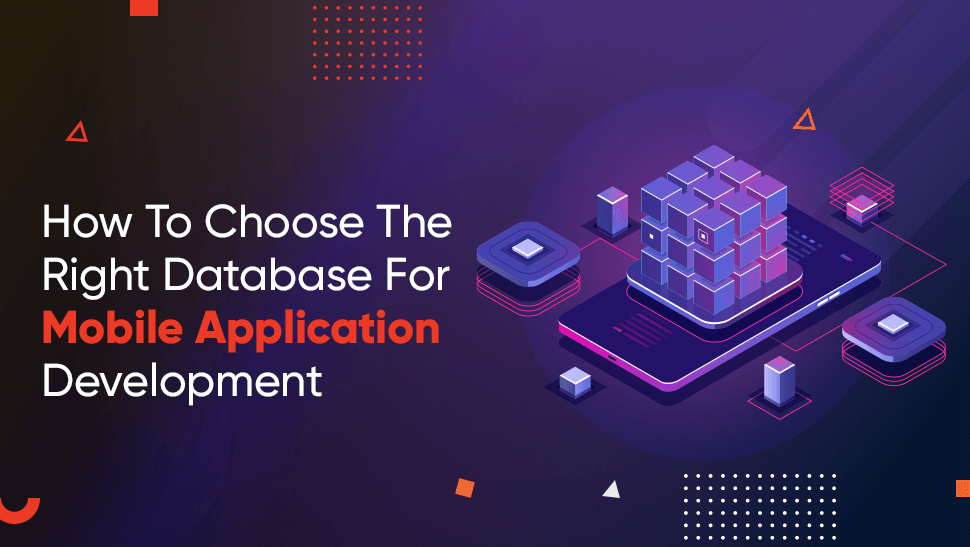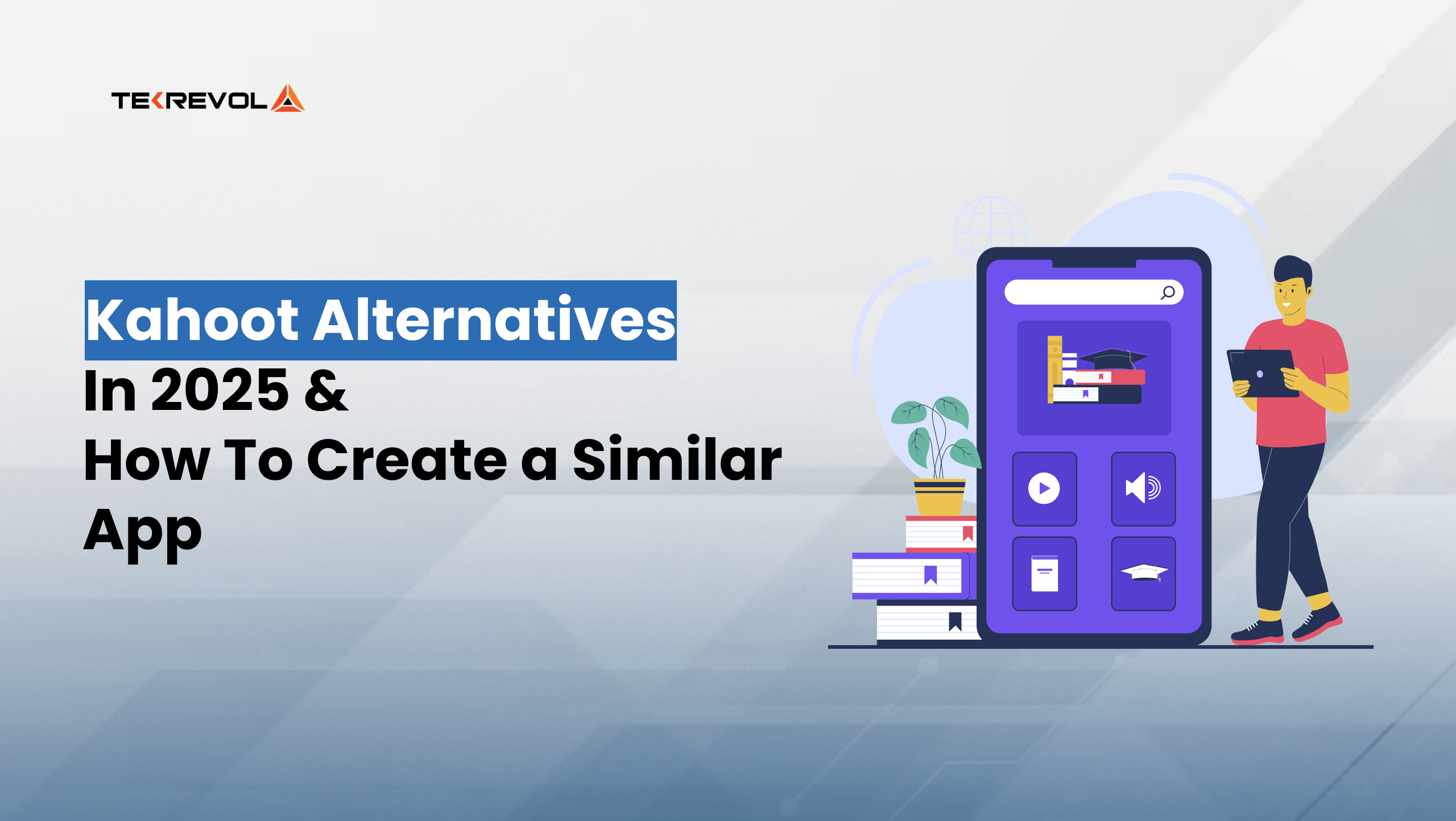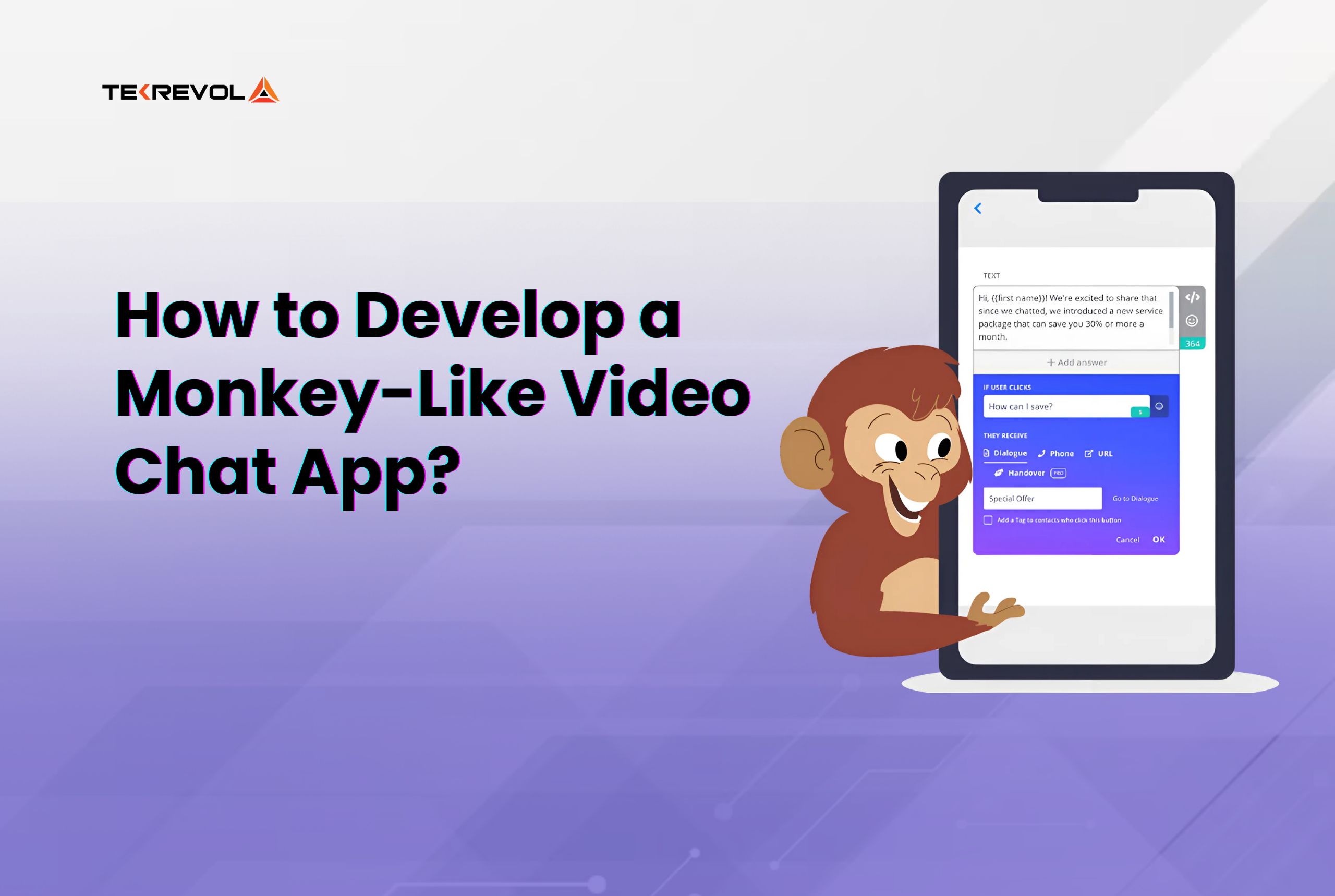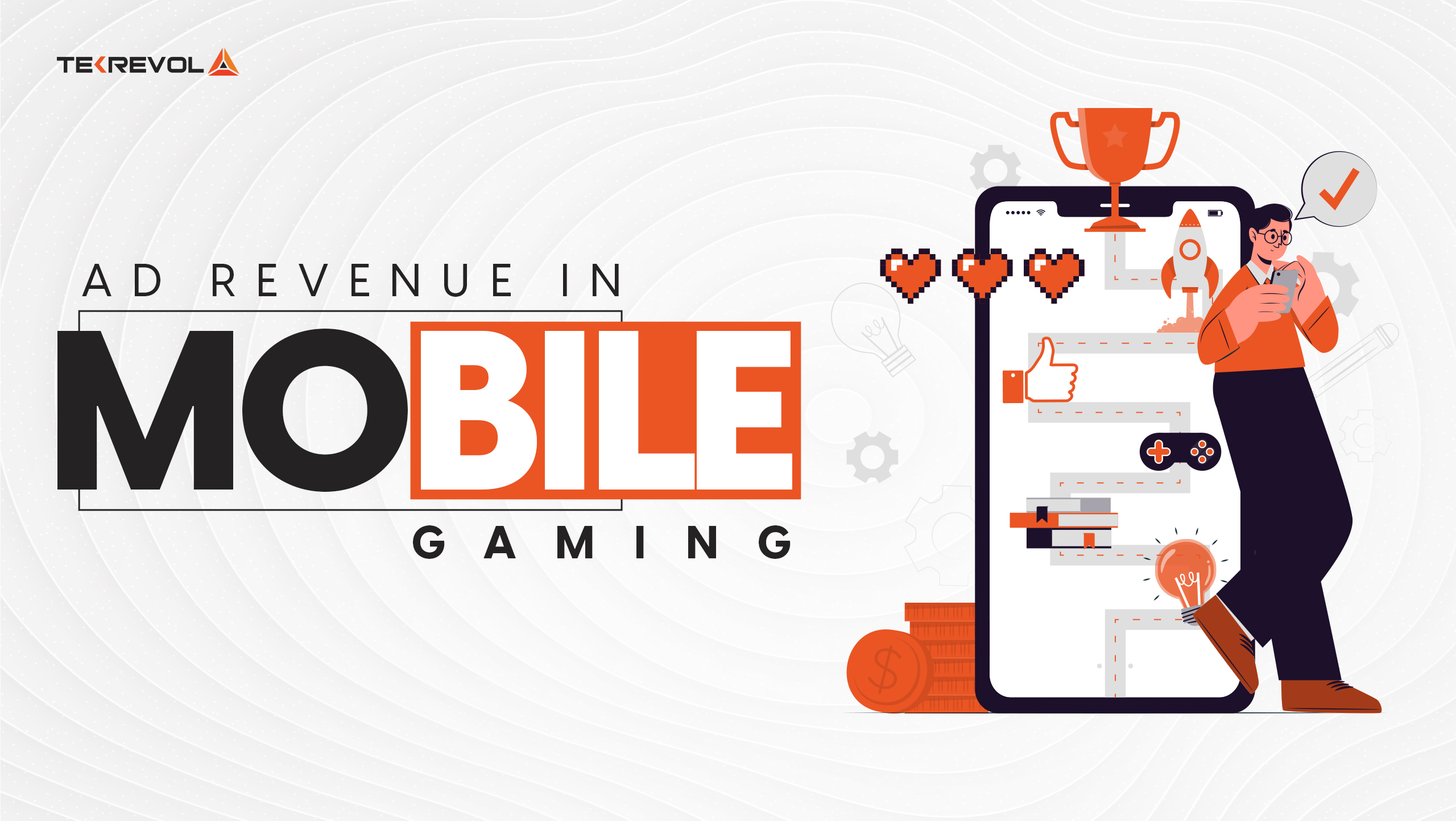You built an amazing app! Now what? Without smart mobile app promotion, even the best apps can go unnoticed. Whether you’re launching a productivity tool or a service, the right app promotion ideas help you reach users and grow.
In 2025, users are bombarded with apps, so standing out requires more than luck. You need proven mobile app promotion strategies that cover ASO, social media, email, and more.
This guide offers mobile app marketing examples to help you promote your app successfully and retain users long-term. From free mobile app promotion routes to paid campaigns, you’ll learn how to promote your app for free and how to advertise your mobile app in cost-effective ways.
Getting the user’s attention in this congested app market is not an easy task. You can develop the most revolutionary app on the planet, but without a good marketing strategy, it may never get to those who require it.
So, let’s get started!
What Is Mobile App Promotion All About?
Mobile app promotion is the process of creating awareness, driving downloads, and keeping users engaged over the long term. It starts well before your launch and continues as you update and grow your app.
A winning mobile app promotion strategy is more than ads or posts; it’s a structured plan that moves through multiple phases.
In 2025, mobile app downloads worldwide are projected to reach over 260 billion, highlighting the fierce competition and the growing need for innovative app promotion ideas.
Here’s how it typically works:
1. Pre-Launch Phase: Building a Solid Foundation
Even before your app goes live, you need groundwork that ensures visibility. This includes audience research, competitor analysis, brand positioning, landing page creation, and early teaser campaigns. Preparing this way ensures stronger results once you launch.
Key Focus Areas:
- Audience research & competitor analysis
- Branding and app messaging
- Landing page creation and SEO
- Early outreach and teaser campaigns
2. Launch Phase: Creating Buzz and Driving Initial Downloads
It’s now time for your app to be presented to people everywhere. In this phase, the company may perform both a soft and a hard launch. While a soft launch helps adjust the product before the big launch, the hard launch seeks to spread news about it extensively.
At this phase, marketers focus on adding users, promoting in app stores, joining forces with popular influencers, and connecting with members of the press.
Key Activities:
- Optimize app store presence (ASO)
- Collaborate with influencers and press
- Leverage mobile app promotion examples like referral programs or early-bird rewards
- Explore both paid ads and how to promote your app on social media effectively
3. Post-Launch Phase: Engaging and Retaining Users
After launch, success is all about keeping users active. This means acting on feedback, releasing updates, and using mobile app promotion ideas like push notifications, in-app offers, and user communities to build long-term loyalty.
It is important to come up with content marketing plans and support a community that brings people back regularly.
Post-Launch Priorities:
- Check comments and feedback left by other users
- Keep releasing new updates and solutions for any problems.
- Use tools like push notifications and give special offers to encourage users to keep interacting with the app.
- Communities form better on social media and in user forums.
4. Maintenance & Growth Phase: Optimizing for Long-Term Success
Sustaining growth involves analyzing performance data, testing new features, and scaling acquisition efforts. Brands often adopt mobile app promotion strategies like lifecycle marketing automation, global expansion, and monetization models to fuel long-term ROI.
Pro tip: Whether you’re looking for free mobile app promotion or investing in app promotion services, consistency across all phases makes the difference between short-lived hype and sustainable growth
- Apps with proper marketing campaigns generate 3x more installs.
- Ready to apply proven strategies to your own app launch?
What Are the Most Important Mobile App Marketing Terms in 2025?
There are a few key terms you’ll keep hearing in mobile app promotion, things like attribution, CTR, user retention rate, KPIs, and CTAs. Understanding them is essential for running smarter campaigns.
Let’s break down each one so you know exactly how they work.
- Attribution: It is the process of linking a user action, like an app install or an in-app purchase, to a concrete marketing effort, paid ad, social media campaign, or email newsletter. Attribution tells what has been working for you.
- Call to Action (CTA): A CTA is a straightforward suggestion to users, encouraging them to take an immediate step, like Download Now, Sign Up Free, or Get Started. It is what converts mere interest into action.
- Campaign Optimization: It is about adjusting your marketing campaigns by analyzing performance data and making key changes in strategy with the ultimate goal of bettering results, based on key metrics and insights.
- Churn: It is when users quit using your app. To sustain users and grow effectively, one has to keep churn rates as low as possible.
- Key Performance Indicators (KPIs): KPIs are the measurable values that tell you how well your marketing strategies are performing. They are the scorecard of your campaign.
10 Proven Mobile App Promotion Strategies to Grow Your App
Mobile app promotion strategies aim to increase downloads and user engagement. The fresh and actionable strategies, like ASO, Beta launch, and social media marketing, will enable you to drive downloads, boost engagement, and establish a loyal user base.
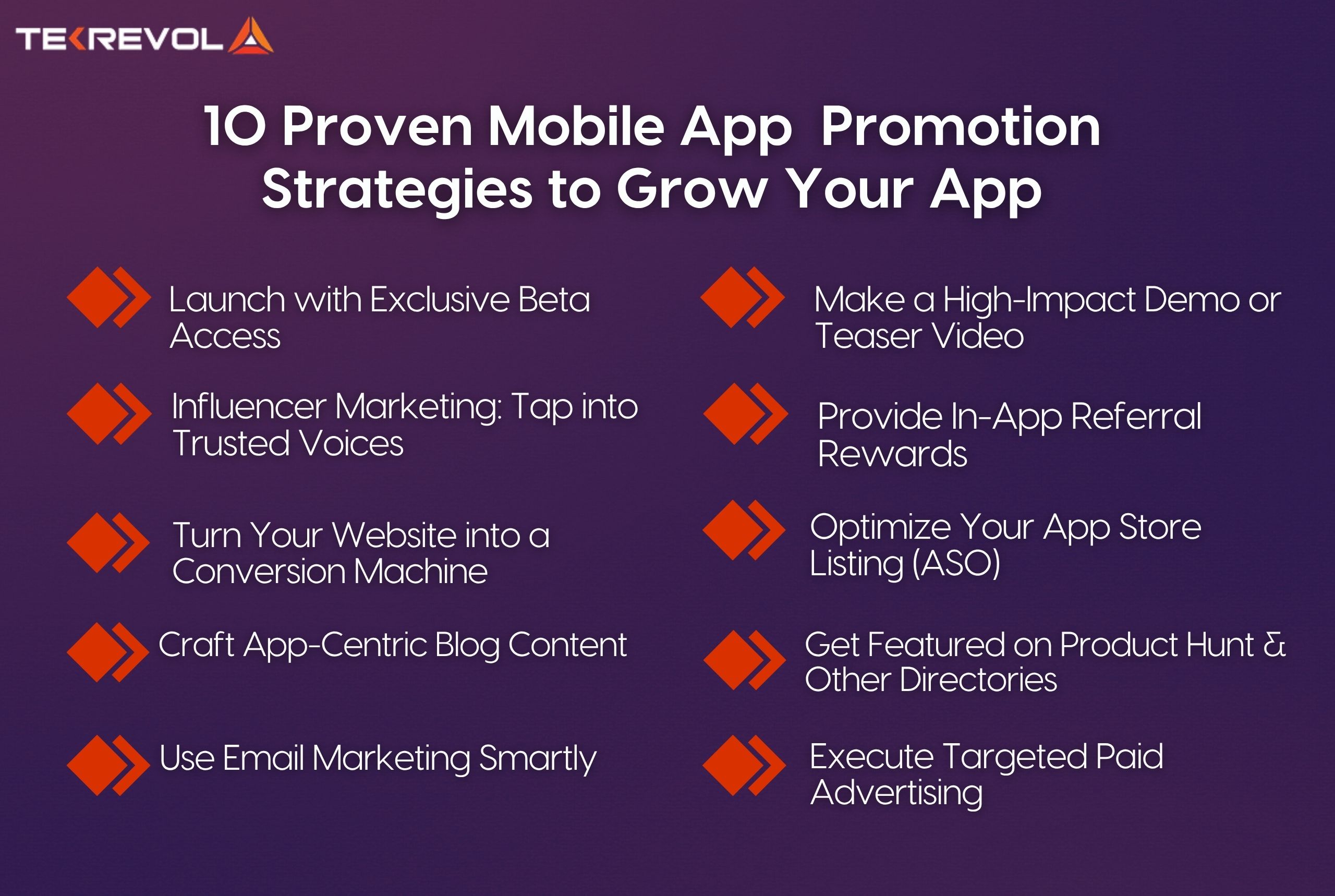
So, here’s a breakdown of each:
1. Launch with Exclusive Beta Access
Opening up the app for private beta testing gives users a taste of exclusivity, which creates some buzz. Feedback would go into bug fixes or feature adjustments due to real-time usage. In return, your early users feel like insiders, which boosts the chances of conversion into advocates and retainers.
Tips
- Offering limited beta slots will help generate demand.
- Spread the word on platforms like Product Hunt, Betalist, or Reddit to invite beta testers.
- Gather feedback with in-app surveys or with Typeform.
Checklist
- Create a beta sign-up landing page.
- Feedback loop resolution.
- Limited-time early access offers
2. Influencer Marketing: Tap into Trusted Voices
Influencers hold the power to drive awareness and downloads, especially when their audience aligns with your app’s target market.
They enable you to tap into niche audiences that respect their opinions, and this generates high-quality downloads as well as deeper community engagement.
Tips:
- Employ tools such as BuzzSumo or Upfluence to discover relevant influencers.
- Target influencers with 10k–100k followers to achieve improved ROI.
- Create long-term collaborations for constant promotion.
Example: A fitness app cooperating with health micro-influencers on Instagram can obtain high-converting traffic by reaching wellness-conscious audiences.
3. Turn Your Website into a Conversion Machine
Your site’s already receiving visitors, maximize it by promoting your app strategically at major touchpoints. From homepage banners to clever pop-ups and app-specific landing pages, each visitor is a potential app user if directed in the right manner.
- App download CTAs in a sticky header or footer.
- Add QR codes for quick mobile access.
- Include app CTAs on blog pages, FAQs, and contact forms.
Example: Dropbox used its website to convert web users into app users by placing strong CTAs and download prompts throughout its homepage and user dashboard.
Conversion Boosters:
- Homepage banner with app download links
- Add mobile app promotion to the thank-you or checkout page
- Implement exit-intent pop-ups with download incentives
4. Craft App-Centric Blog Content
Use your blog as a storytelling platform to showcase how your app solves real-world problems. Whether through tutorials, feature highlights, or user success stories, informative blog content drives traffic and encourages readers to explore and download your app.
Tips:
- Optimize for keywords like “best apps for [your niche]”.
- Include screenshots, GIFs, and videos to demonstrate features.
- End each blog with a CTA to download the app.
Example: A budgeting app can publish blogs on “How to Save $1,000 in 3 Months Using This App,” offering real examples and linking to the app.
5. Use Email Marketing Smartly
Email is still one of the most direct and effective marketing channels. Integrate app promotions into newsletters, transactional emails, and signatures to subtly remind and invite your audience to download and engage with your app.
78% of marketers say email is vital to app user retention, and mobile users check their email 3x more frequently than desktop users.
Tips:
- Include app links in email footers and signatures.
- Add a download CTA in newsletters and post-purchase emails.
- Use segmentation to promote relevant app features.
Example: Most of the e-commerce brands include “Shop faster with our app” links in order and shipping confirmation emails.
Email Integration Checklist:
- Add an app banner in every newsletter
- Create a welcome email series with an app download prompt
- Track downloads via email campaign UTM links
6. Make a High-Impact Demo or Teaser Video
A good demo or teaser video can be seen as a visual shortcut to explain the value of your app. Highlight your app’s core features, showcase the user interface, and make a compelling case for downloads, all in a 30–60 second video, ready to share across ads and social platforms.
95% of marketers say video is an important part of their mobile marketing strategy, and apps with a video preview on the App Store see 35% more conversions.
Tips:
- Use the “Why → How → What” structure.
- Keep it below 60 seconds and have a firm CTA at the end.
- Optimize for mobile watch.
Example: The language learning app Duolingo employs offbeat, concise videos that emphasize how easy and enjoyable it is to utilize the app, fueling its viral spread.
7. Provide In-App Referral Rewards
A built-in referral program encourages word-of-mouth promotion by rewarding users for inviting others. These incentives, like discounts, premium access, or virtual rewards, boost user engagement and attract new users with built-in social proof.
Referral users are 4x more likely to convert and have a 37% higher retention rate compared to users acquired through other channels.
Tips:
- Offer double-sided rewards to both the referrer and the new user.
- Make sharing effortless via WhatsApp, SMS, or email.
- Promote the referral program with in-app banners and notifications.
Referral Strategy:
- Create a shareable referral code
- Show referral reward progress
- Integrate a referral prompt on successful user actions
8. Optimize Your App Store Listing (ASO)
App Store Optimization (ASO) is important to grow your app’s visibility in the Apple App Store and Google Play Store. An interesting title, readable screenshots, keyword-relevant descriptions, and convincing descriptions can remarkably boost your organic downloads.
According to research, 70% of App Store visitors use search to discover apps, while almost 65% of downloads happen directly after a search.
Tips:
- Conduct keyword research that your target users are looking for.
- Use high-quality screenshots and app preview videos.
- A/B test various titles, icons, and descriptions.
- Clear and benefit-focused app description
- Customer reviews and frequent updates
9. Get Featured on Product Hunt and Other Directories
Being featured on directories like Product Hunt, Betalist, or AlternativeTo can bring an early surge of users and press attention. These platforms are ideal for early adopters and tech-savvy audiences who love discovering new apps.
Tips:
- Time your launch to align with community activity (e.g., early in the day on Product Hunt).
- Prepare visuals, GIFs, and a clear pitch beforehand.
- Engage in the comment section to boost visibility.
Example: When Notion launched on Product Hunt, it received massive upvotes, which helped it get coverage from tech blogs and thousands of new sign-ups in a few days.
10. Execute Targeted Paid Advertising
Investing in targeted paid advertising on Google, Meta (Facebook/Instagram), TikTok, and even Reddit will yield consistent traffic and downloads if executed well. It is all about beginning with a small scale, optimizing creatives, and scaling campaigns based on performance.
Tips:
- Execute A/B tests on creatives and CTAs.
- Utilize lookalike and retargeting audiences.
- Prioritize cost-per-install (CPI) and lifetime value (LTV) metrics.
- Define your target audience and platforms.
- Monitor and optimize campaigns weekly.y
- Only 1 in 10 apps reach 1,000 downloads.
- We help you break that barrier with strategies that actually drive results.
How to Evaluate Your App’s Performance & ROI?
To assess your app’s success and profitability, monitor core KPIs, review expenses, and measure the value generated over time. Here are the most important metrics every app marketer and owner should monitor:
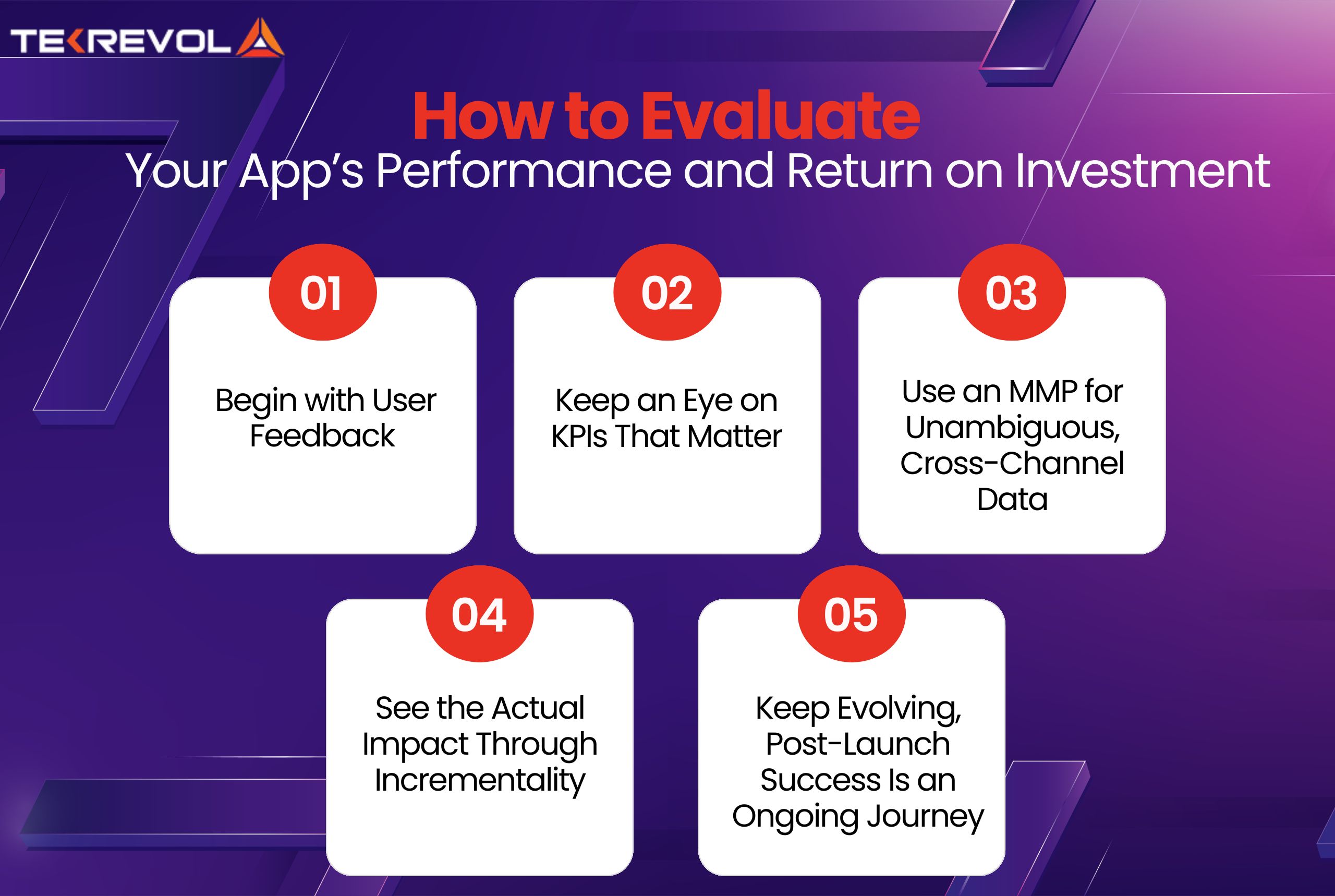
-
Begin with User Feedback
User feedback is a fast and authentic method to evaluate your app’s performance. Implement easy channels, such as in-app surveys, support chat, or email, to capture user opinions and complaints.
A clever trick? Request in-app ratings, direct happy users (4–5 stars) to leave an open review, and direct less happy users to a private support form.
Tip: Respond to feedback promptly; it builds trust, enhances retention, and indicates that you care.
-
Keep an Eye on KPIs That Matter
To really know how your app is doing, use key performance indicators (KPIs) that are aligned with your app’s category and business objectives. Below are some foundational KPIs that every app owner should track:
- Monthly Active Users (MAUs): Shows user retention and app stickiness.
- Customer Acquisition Cost (CAC): Illustrates whether your user acquisition efforts are cost-effective.
- Churn Rate: Reports the number of users who stop using your app—imperative for UX gap identification.
- Lifetime Value (LTV): Calculates the total revenue a user creates over their lifetime.
- Average Time to First Transaction: Monitors how well users convert.
- Session Length & Sessions per User: Emphasize how frequently and how heavily users use your app.
- Average Revenue Per User (ARPU): Tracks the success you’re having in monetizing your users.
- Return on Ad Spend (ROAS): Measures the profitability of your paid media efforts.
They assist in identifying opportunities for growth, optimizing marketing campaigns, and making decisions backed by data that translate into better ROI.
-
Use an MMP for Unambiguous, Cross-Channel Data
If you are working across multiple marketing platforms, it’s difficult to get a single view of performance. That is where an MMP helps. MMPs provide you with objective, cross-platform measurement that enables you to evaluate campaign performance free from the influence of potentially skewed platform dashboards.
By bringing your metrics together in one dashboard, an MMP enables you to:
- Pinpoint the highest-performing acquisition channels.
- Monitor user journeys from install to engagement.
- See what drives high-quality users.
This understanding is central to investing more intelligently and continually refining your marketing budget.
-
See the Actual Impact Through Incrementality
With restrictions on identifiers and cookie-based tracking, it’s becoming more difficult to track users in today’s privacy-first environment. To measure marketing effectiveness, you need a new approach: incrementality testing.
Incrementality informs you about:
- If your marketing activities had an actual impact (positive, neutral, or negative).
- How much value did they generate above organic activity?
For example, when ads only capture users who were already likely to buy, there’s no real gain. But when they bring in new customers or increase purchases, they’re worth the cost. This makes it easier to invest wisely.
-
Keep Evolving, Post-Launch Success Is an Ongoing Journey
An app’s success is not only at launch, but it is maintained through never-ending innovation and iteration. Remain dedicated to frequent updates, bug fixes, and performance optimization. Pay attention to user demand, react to market trends, and add features that enhance value and usability.
The more you integrate your development cycle with user feedback and engagement trends, the better your chances of building a loyal, expanding user base.
Conclusion
Creating a great app is only the beginning; true success depends on smart, consistent mobile app promotion. The exciting part? You don’t always need a big budget.
There are plenty of free mobile app promotion methods that can boost downloads and visibility. From referral campaigns to mobile app promotion ideas like social media contests, small steps can make a big impact.
Still, effective app promotion strategies require planning and constant optimization. If managing campaigns, handling ASO, or figuring out how to promote your app on social media feels overwhelming, you don’t have to do it alone.
At TekRevol, we go beyond building apps. Alongside custom development, we provide full-scale digital marketing services, including App Store Optimization (ASO), social media marketing, and performance tracking to ensure your app reaches the right audience and grows sustainably.
- Want to see how these strategies work for your app?
- Schedule a personalized demo with our marketing team today.



